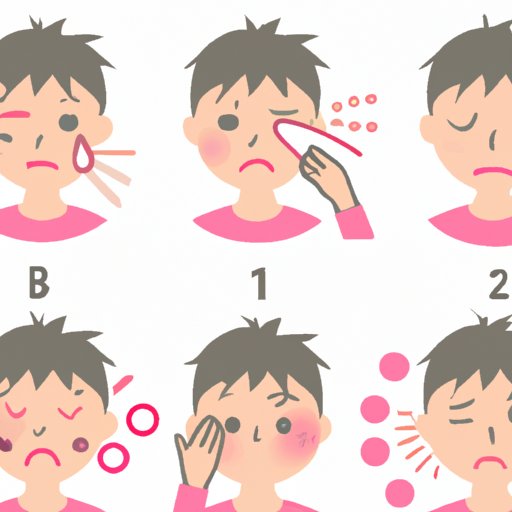Introduction
Pink eye – also known as conjunctivitis – is a common eye infection that occurs when the conjunctiva (the clear membrane covering the white part of the eyeball and inner eyelid) becomes inflamed. According to the Centers for Disease Control and Prevention (CDC), “Pink eye is one of the most commonly diagnosed eye infections in both children and adults.”
Pink eye can be caused by a number of different factors, including bacterial and viral infections, allergies, foreign objects in the eye, and contact lens use. Symptoms can range from mild to severe, and may include redness, itching, swelling, discharge, and blurred vision. Fortunately, there are a variety of treatment options available, ranging from over-the-counter medications to prescription medications and natural remedies. Additionally, there are a few preventive measures that can be taken to reduce the risk of contracting pink eye.

Identifying the Symptoms of Pink Eye
The most common symptom of pink eye is redness in one or both eyes. Other signs and symptoms may include:
- Itching
- Swelling of the eyelids
- Increased sensitivity to light
- Discharge from the eyes, which may be yellowish or greenish
- Crusty eyelashes
- Blurred vision
It is important to note that the symptoms of pink eye vary depending on the underlying cause of the infection. For example, viral pink eye is usually accompanied by a watery discharge, while bacterial pink eye typically causes a thicker, yellowish-green discharge. Additionally, allergic pink eye usually causes itching, burning, and tearing. It is important to understand the differences between the various types of pink eye, as different treatments may be required.

Understanding Common Causes of Pink Eye
Pink eye can be caused by a number of different factors, including bacterial and viral infections, allergies, foreign objects in the eye, and contact lens use. The most common cause of pink eye is an infection from either a virus or bacteria. According to the American Academy of Ophthalmology, “Viral pink eye is usually caused by a virus called adenovirus and is highly contagious. Bacterial pink eye is usually caused by staphylococcus aureus bacteria, but other bacteria such as streptococcus pneumoniae can also cause it.”
Allergies can also cause pink eye. Allergic reactions can be triggered by exposure to allergens such as pollen, dust mites, animal dander, and certain medications. In addition, foreign objects in the eye, such as dirt or makeup, can cause irritation and inflammation. Finally, improper contact lens use can also lead to pink eye.
Exploring Treatment Options for Pink Eye
Treatment for pink eye will depend on the underlying cause. Over-the-counter medications, such as artificial tears and antihistamines, can help relieve the symptoms of pink eye. Prescription medications, such as antibiotics and steroid eye drops, may be needed if the infection does not respond to OTC medications. Additionally, there are a variety of natural remedies that may help reduce the symptoms of pink eye, such as cold compresses, chamomile tea bags, and honey.
In some cases, surgery may be necessary to remove a foreign object in the eye or to correct any damage caused by the infection. It is important to consult with a medical professional before attempting any of these treatments, as they may worsen the condition in some cases.
Examining Prevention Strategies to Avoid Pink Eye
The best way to avoid getting pink eye is to practice good hygiene. This includes washing your hands regularly with soap and water and avoiding touching your eyes with unwashed hands. Additionally, it is important to wear protective eyewear when working with chemicals or engaging in activities that involve potential eye injury. To reduce the risk of spreading pink eye, it is also recommended to limit physical contact with individuals who have been diagnosed with the infection.
Investigating Risk Factors Associated with Pink Eye
Certain factors can put individuals at an increased risk of developing pink eye. These include age (children and elderly individuals are more likely to contract the infection), working environments (such as daycare centers and hospitals), and poor hygiene. Additionally, individuals who wear contact lenses are at an increased risk of developing pink eye due to improper lens care.

Consulting a Medical Professional for Diagnosis and Treatment
If you experience any of the symptoms associated with pink eye, it is important to seek medical attention as soon as possible. A doctor or ophthalmologist can perform tests to determine the underlying cause of the infection and prescribe the appropriate treatment. Tests may include a physical examination of the eye and a culture to identify the bacteria or virus causing the infection. Depending on the severity of the infection, treatment may include OTC medications, prescription medications, or surgery.
Conclusion
Pink eye – also known as conjunctivitis – is a common eye infection that can be caused by a number of different factors, including bacterial and viral infections, allergies, foreign objects in the eye, and contact lens use. Symptoms can range from mild to severe, and may include redness, itching, swelling, discharge, and blurred vision. Fortunately, there are a variety of treatment options available, ranging from over-the-counter medications to prescription medications and natural remedies. Additionally, there are a few preventive measures that can be taken to reduce the risk of contracting pink eye. If you experience any of the symptoms associated with pink eye, it is important to seek medical attention as soon as possible.
By following good hygiene practices, wearing protective eyewear, and limiting contact with infected individuals, you can reduce your risk of developing pink eye. If you do develop any of the symptoms associated with pink eye, it is important to consult a medical professional for proper diagnosis and treatment.
(Note: Is this article not meeting your expectations? Do you have knowledge or insights to share? Unlock new opportunities and expand your reach by joining our authors team. Click Registration to join us and share your expertise with our readers.)
